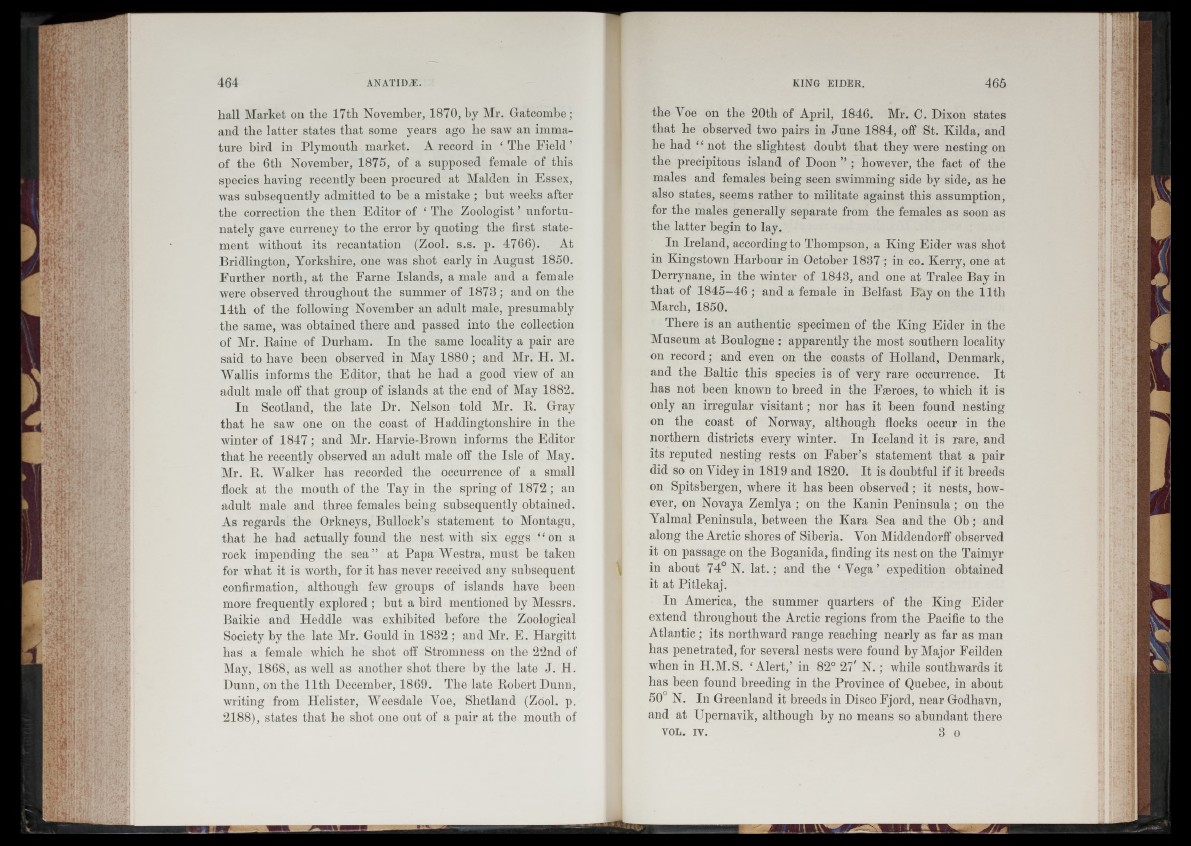
hall Market on the 17th November, 1870, by Mr. Gatcombe;
and the latter states that some years ago he saw an immature
bird in Plymouth market. A record in ‘ The Field ’
of the 6th November, 1875, of a supposed female of this
species having recently been procured at Malden in Essex,
was subsequently admitted to be a mistake ; but weeks after
the correction the then Editor of ‘ The Zoologist ’ unfortunately
gave currency to the error by quoting the first statement
without its recantation (Zool. s.s. p. 4766). At
Bridlington, Yorkshire, one was shot early in August 1850.
Further north, at the Fame Islands, a male and a female
were observed throughout the summer of 1873; and on the
14tli of the following November an adult male, presumably
the same, was obtained there and passed into the collection
of Mr. Raine of Durham. In the same locality a pair are
said to have been observed in May 1880 ; and Mr. H. M.
Wallis informs the Editor, that he had a good view of an
adult male off that group of islands at the end of May 1882.
In Scotland, the late Dr. Nelson told Mr. 11. Gray
that he saw one on the coast of Haddingtonshire in the
winter of 1847 ; and Mr. Harvie-Brown informs the Editor
that he recently observed an adult male off the Isle of May.
Mr. R. Walker has recorded the occurrence of a small
flock at the mouth of the Tay in the spring of 1872 ; an
adult male and three females being subsequently obtained.
As regards the Orkneys, Bullock’s statement to Montagu,
that he had actually found the nest with six eggs “ on a
rock impending the sea ” at Papa Westra, must be taken
for what it is worth, for it has never received any subsequent
confirmation, although few groups of islands have been
more frequently explored ; but a bird mentioned by Messrs.
Baikie and Heddle was exhibited before the Zoological
Society by the late Mr. Gould in 1832 ; and Mr. E. Hargitt
has a female which he shot off Stronmess on the 22nd of
May, 1868, as well as another shot there by the late J. H.
Dunn, on the 11th December, 1869. The late Robert Dunn,
writing from Helister, Weesdale Yoe, Shetland (Zool. p.
2188), states that he shot one out of a pair at the mouth of
the 4 oe on the 20th of April, 1846. Mr. C. Dixon states
that he observed two pairs in June 1884, off St. Kilda, and
he had “ not the slightest doubt that they were nesting on
the precipitous island of Doon ’’ ; however, the fact of the
males and females being seen swimming side by side, as he
also states, seems rather to militate against this assumption,
for the males generally separate from the females as soon as
the latter begin to lay.
In Ireland, according to Thompson, a King Eider was shot
in Kingstown Harbour in October 1837 ; in co. Kerry, one at
Derrynane, in the winter of 1843, and one at Tralee Bay in
that of 1845-46 ; and a female in Belfast B'ay on the 11th
March, 1850.
There is an authentic specimen of the King Eider in the
Museum at Boulogne : apparently the most southern locality
on record; and even on the coasts of Holland, Denmark,
and the Baltic this species is of very rare occurrence. It
has not been known to breed in the Faeroes, to which it is
only an irregular visitant; nor has it been found nesting
on the coast of Norway, although flocks occur in the
northern districts every winter. In Iceland it is rare, and
its reputed nesting rests on Faber’s statement that a pair
did so on Yidey in 1819 and 1820. It is doubtful if it breeds
on Spitsbergen, where it has been observed; it nests, however,
on Novaya Zemlya ; on the Kanin Peninsula; on the
Yalmal Peninsula, between the Kara Sea and the Ob; and
along the Arctic shores of Siberia. Yon Middendorff observed
it on passage on the Boganida, finding its nest on the Taimyr
in about 74° N. lat. ; and the ‘ Yega ’ expedition obtained
it at Pitlekaj.
In America, the summer quarters of the King Eider
extend throughout the Arctic regions from the Pacific to the
Atlantic; its northward range reaching nearly as far as man
has penetrated, for several nests were found by Major Feilden
when in H.M.S. ‘Alert,’ in 82° 21' N .; while southwards it
has been found breeding in the Province of Quebec, in about
50° N. In Greenland it breeds in Disco Fjord, near Godhavn,
and at Upernavik, although by no means so abundant there
VOL. iv. 3 o